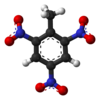Trinitrotoluene
|
|
|||
 |
|||
| Names | |||
|---|---|---|---|
|
Preferred IUPAC name
2-Methyl-1,3,5-trinitrobenzene
|
|||
| Other names
2,4,6-Trinitrotoluene
TNT Trilite Tolite Trinol Trotyl Tritolo Tritolol Triton Tritone Trotol Trinitrotoluol 2,4,6-Trinitromethylbenzene |
|||
| Identifiers | |||
|
118-96-7 |
|||
| 3D model (Jmol) | Interactive image | ||
| Abbreviations | TNT | ||
| ChEMBL |
ChEMBL1236345 |
||
| ChemSpider |
8073 |
||
| DrugBank |
DB01676 |
||
| ECHA InfoCard | 100.003.900 | ||
| EC Number | 204-289-6 | ||
| KEGG |
C16391 |
||
| PubChem | 11763 | ||
| RTECS number | XU0175000 | ||
| UNII |
H43RF5TRM5 |
||
| UN number |
0209 – Dry or wetted with < 30% water 0388, 0389 – Mixtures with trinitrobenzene, hexanitrostilbene |
||
|
|||
|
|||
| Properties | |||
| C7H5N3O6 | |||
| Molar mass | 227.13 g·mol−1 | ||
| Appearance | Pale yellow solid. Loose "needles", flakes or prills before melt-casting. A solid block after being poured into a casing. | ||
| Density | 1.654 g/cm3 | ||
| Melting point | 80.35 °C (176.63 °F; 353.50 K) | ||
| Boiling point | 240.0 °C (464.0 °F; 513.1 K) (decomposes) | ||
| 0.13 g/L (20 °C) | |||
| Solubility in ether, acetone, benzene, pyridine | soluble | ||
| Vapor pressure | 0.0002 mmHg (20°C) | ||
| Explosive data | |||
| Shock sensitivity | Insensitive | ||
| Friction sensitivity | Insensitive to 353 N | ||
| Detonation velocity | 6900 m/s | ||
| RE factor | 1.00 | ||
| Hazards | |||
| Safety data sheet | ICSC 0967 | ||
|
EU classification (DSD)
|
|
||
| R-phrases | R2, R23/24/25, R33, R51/53 | ||
| S-phrases | (S1/2), S35, S45, S61 | ||
| NFPA 704 | |||
| Flash point | 167 °C (333 °F; 440 K) | ||
| Lethal dose or concentration (LD, LC): | |||
|
LD50 (median dose)
|
795 mg/kg (rat, oral) 660 (mouse, oral) |
||
|
LDLo (lowest published)
|
500 mg/kg (rabbit, oral) 1850 mg/kg (cat, oral) |
||
| US health exposure limits (NIOSH): | |||
|
PEL (Permissible)
|
TWA 1.5 mg/m3 [skin] | ||
|
REL (Recommended)
|
TWA 0.5 mg/m3 [skin] | ||
|
IDLH (Immediate danger)
|
500 mg/m3 | ||
| Related compounds | |||
|
Related compounds
|
picric acid hexanitrobenzene 2,4-Dinitrotoluene |
||
|
Except where otherwise noted, data are given for materials in their standard state (at 25 °C [77 °F], 100 kPa).
|
|||
|
|
|||
| Infobox references | |||
![]() N Dangerous for the environment
N Dangerous for the environment
Trinitrotoluene (/ˌtraɪˌnaɪtroʊˈtɒljuːˌiːn, -ljəˌwiːn/;TNT), or more specifically 2,4,6-trinitrotoluene, is a chemical compound with the formula C6H2(NO2)3CH3. This yellow-colored solid is sometimes used as a reagent in chemical synthesis, but it is best known as an explosive material with convenient handling properties. The explosive yield of TNT is considered to be the standard measure of bombs and other explosives. In chemistry, TNT is used to generate charge transfer salts.
...
Wikipedia



